

LearnEnglish Magazine April Fools Day.
Phonemic chart. Phonemic chart. Tubequizard. English grammar videos for kids. ML Maximising the use of English. Managing the lesson. Institute of Education - UCL – University College London. During school closures, it's important that children are able to continue their learning.
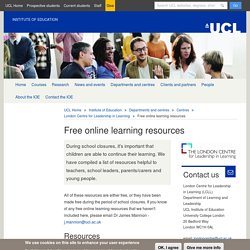
We have compiled a list of resources helpful to teachers, school leaders, parents/carers and young people. All of these resources are either free, or they have been made free during the period of school closures. If you know of any free online learning resources that we haven't included here, please email Dr James Mannion - j.mannion@ucl.ac.uk Resources Relating to coronavirus Talking about Coronavirus with Children (Engage Education website)Covid-19: Child-led learning resource (PDF, 5MB) on The Economist Educational Foundation websiteDave the Dog is worried about coronavirus (Nurse Dotty Books website) - a story book for young children that aims to help them learn about coronavirus without fear.The coronavirus explained and what you should do (YouTube Video, Kurzgesagt – In a Nutshell) - an excellent, informative animated video, explaining how the virus works and what we need to do to defeat it.
Art. BrainPOP. Activity Village - Colouring Pages, Puzzles, Kids Crafts and Fun Activities for Kids. Digital Textbooks & Education Resources. Vooks — Storybooks Brought to Life. Teacher Appreciation — Vooks. Free primary and secondary school teaching resources - BBC Teach. The British Council's English Channel combines arts content with English-language learning. Empower Every Voice.
The Ultimate Guide to Easily Make Instructional Videos. What do you do when you need to learn something new?
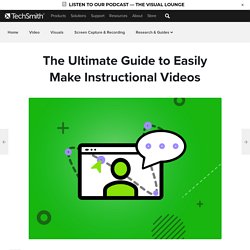
What if you need to know how to fix something? Or what if you need to learn how to use a new software or service? You probably look for a video. According to a recent TechSmith study, 53% of people reported watching two or more instructional videos per week (up 152% compared to 2013). Regardless of your industry, instructional videos are the best delivery method if you’re serious about teaching others, growing your business, or building an online course. Learn English Online. What to do when schools close for coronavirus. The U.N. organization that monitors global education said the number of children missing school globally is unprecedented.

The COVID-19 outbreak has disrupted the education of nearly 300 million students globally.Thirteen countries, including China, Italy and Japan, have shut schools nationwide as of Wednesday (4.03.20.)A handful of schools in the United States have canceled classes over the coronavirus. Source: CNBC. No matter where you live the closure of schools is likely to happen. UNESCO will hold an emergency meeting on March 10 over coronavirus-related school closures. 6 tips for moving your teaching online - How do you adapt your teaching techniques for the virtual classroom? - Oxford TEFL.
Have you ever thought of teaching online?

Adding this skill to your teaching repertoire can open up a host of opportunities for you, from additional work to starting your own business. You could also vastly improve your chances of finding teaching work online, reaching more potential students and providing the best possible service by taking our Teaching English Online course. 6 Things to Consider When Using Zoom's Mobile App - Zoom Blog. 6 Things to Consider When Using Zoom’s Mobile App Mobile communication has become one of the greatest achievements of the 21st century.
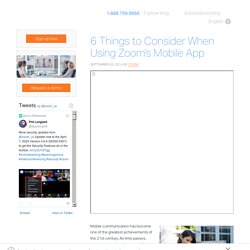
As time passes, people are moving further and further away from their stationary workplaces to venture into a realm where they can get work done and business taken care of from a device that is held on the palms of their hands. This is not to say that we are abandoning the PC. Instead, we are recognizing that our other devices present us with greater flexibility.
Since Zoom works on iOS and Android devices, you have the ability to communicate through our software with anyone at any time, no matter where you are. How to get started as an online teacher of English. Have you thought about teaching English online? Emma Segev gives some practical tips and useful websites for getting started in one of our top five articles of all time, illustrated by artist Jamie Johnson. Teaching online - tech tools and the tutor's role. About the webinar The British Council is committed to supporting the use of technology for the continuation of education in a crisis.
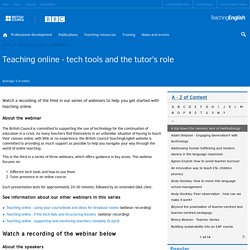
As many teachers find themselves in an unfamiliar situation of having to teach their classes online, with little or no experience, the British Council TeachingEnglish website is committed to providing as much support as possible to help you navigate your way through the world of online teaching. This is the third in a series of three webinars, which offers guidance in key areas. Teaching online - if the tech fails and structuring lessons. About the webinar The British Council is committed to supporting the use of technology for the continuation of education in a crisis.
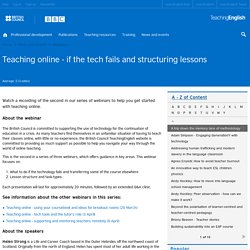
As many teachers find themselves in an unfamiliar situation of having to teach their classes online, with little or no experience, the British Council TeachingEnglish website is committed to providing as much support as possible to help you navigate your way through the world of online teaching. This is the second in a series of three webinars, which offers guidance in key areas. This webinar focuses on: Teaching online - using your coursebook and ideas for breakout rooms.
About the webinar The British Council is committed to supporting the use of technology for the continuation of education in a crisis.
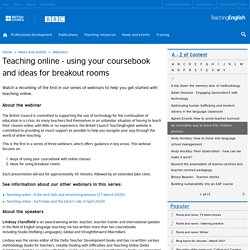
Ideas for using the coursebook creatively. Here is the second extract from the latest British Council publication 'Creativity in the English Language classroom' edited by Alan Maley and Nik Peachey.
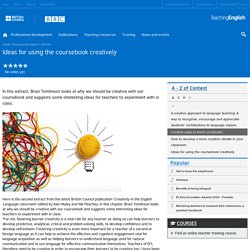
Fifteen ways to adapt your textbook so your students aren't bored to death. Unfortunately, teachers may only be given the textbook without any professional development or additional curriculum resources. It can be challenging, especially for newer teachers, to figure out how to use the textbook to meet the needs of culturally and linguistically diverse students who may be at different levels of English proficiency.
It can also be difficult if the textbook is outdated or not well-designed in terms of instructional practice. Textbooks do have some advantages. They can provide a guide for effective language teaching, contain helpful models, save teachers time, and are usually leveled and aligned to standards. However, they can also present a danger when they are viewed (by teachers, administrators, or districts) as the “only” curriculum or one that must be followed precisely. Rachael Roberts - Planning for differentiation. About the webinar The session will start by looking at some of the ways in which learners can differ from each other - needs, interests and abilities.

We will briefly consider the term 'mixed ability' and why 'differentiation' is becoming more popular, and what exactly it means. Writing activities. Kids and writing. In the classroom there are many ways of using these writing activities to help children practise their English whilst developing their creativity and imagination.
Here are some examples. 1. Write a story Before writing, ask learners to tell you about stories they've already read. Who are the main characters? Product and process writing: A comparison. The best practice in any situation will depend on the type of student, the text type being studied, the school system and many other factors. Thus, this article cannot prescribe a system for the teaching of writing that is optimal for all teaching situations.
Rather, I hope to describe and contrast two popular, yet very different, approaches and examine how both can be used in the classroom. A product approach A process approach A summary of the differences Which approach to use One or the other Further reading. Teaching speaking skills 1. While it is a bit of an exaggeration, students clearly feel that classroom-based speaking practice does not prepare them for the real world. Why do students so often highlight listening and speaking as their biggest problems? Partly because of the demands of listening and speaking and partly because of the way speaking is often taught. It usually consists of language practice activities (discussions, information-gap activities etc.) or is used to practise a specific grammar point.
Neither teaches patterns of real interaction. Kids and speaking. Personalised speaking. What our students bring to the learning environment is our richest resource. But if the lives they lead are to be at the centre of the courses we teach, are we guaranteed that students will talk freely and be interested in what their fellow classmates tell them?
TeachingEnglish. The magic of story time. Where the 'magic' liesStories provide shared contexts for rich, natural language development from a very young age, and throughout the primary years. The 'magic' lies in the way stories potentially engage children's hearts and minds, as people and as thinkers, with issues that are relevant, real and important to them. Analysing Language. Checking understanding generally follows the isolation of new language which has been presented in context, analysed and fully explained. It is this analysis and explanation stage which is the focus here. Course planning. Make Learning Awesome! PLC planning for differentiation inclusivity checklist.
Katherine Bilsborough: Lesson plans – less is more. You can travel without a list of course but you will avoid a few problems if you spend a bit of time planning – not a whole week though. That would be silly. A few minutes should be enough. PLC stages in reading and listening lessons. BusyTeacher.org. BusyTeacher.org. TeachingEnglish. L1. L1. Writing and young learners. Writing and Young Learners. How to maximise the language learning of senior learners. Rachael Roberts - Motivation. Motivating the unmotivated. My lesson plan. Lesson plan 3 1. ESL warm-up activities and time fillers – 34 fun ways to start a class. Warmers and fillers booklet. Five essential tips for teaching very young children English.
Total physical response - TPR. IATEFL 2018: Safe Speaking Environments - What? Why? How? Motivating the unmotivated. Equal opportunity and diversity: The handbook for teachers of English. EO D Learner Materials, Primary. This Jigsaw Game Will Make Test Prep Fun and Productive.
UL 1.15 differentiating content commentary. UL Differentiating tasks. UL Differentiating tasks. UL 1.15 task differentiating content task. UL successful speaking activities. Teaching Speaking - Unit 1: Introductions. British Council LearnEnglish KidsLearnEnglish Kids for parents. Activities for first lessons 1. Learning and Exploring Through Play. Warmers. Rachael Roberts - Breaking the ice. UL Getting to know you activities. Online video for ELT. The role of homework. What is Differentiated Instruction? Examples and Strategies. Adapting materials for mixed ability classes. Freeze the writing - A way to make writing tasks a group activity. Creative group writing. Using students' first languages in the classroom.
The 5 Minute Lesson Plan 2007. Teaching one to one. How To Teach ESL Online - Teach ESL Online.